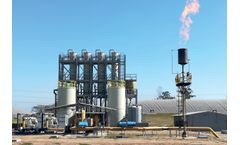H2s Concentrations In Biogas Articles & Analysis
9 articles found
Under anaerobic conditions, sulfur-reducing bacteria acquire oxygen from sulfate (SO4) converting it into sulfide (S2-) that will give rise to H2S and hence the presence of H2S in biogas. Figure 1 The hydrogen sulfide concentration in the gas is a function of the digester feed substrate and the inorganic sulfate content. ...
The composition of the biogas depends entirely on the nature of the waste used and the conditions under which anaerobic digestion is carried out. Generally, the biogas is used for energy recovery, which is determined by the methane concentration. However, a purification of certain contaminants with abrasive and corrosive character, such as ...
Fluence technology scrubs hydrogen sulfide from biogas before it's used to generate electricity. The Fluence biogas desulfurization system installed at the Citrusvil plant uses four washing columns as well as two oxidation tanks. Citrusvil, a large, South American citrus-processing company, has a focus on building sustainability into its production systems. This extends to using waste-to-energy ...
50 years after The Beatles barged their way into the public consciousness, fellow Merseysiders H2 Energy hope to herald a new wave of inspiration and confidence for the renewable energy sector by introducing their Bio Refining process. It would be quite wrong to describe H2 Energy as the new kids on the block however, as there is an enviable pedigree lurking behind the companies youthful good ...
A farm-scale biogas desulfurization system was designed and tested for H2S removal efficiency from livestock biogas. ...
Conventional sewage treatment: Sludge line: 20 kg DM IE year to sludge; 1.500.000 tons sludge per year Sludge treatment and disposal: 40% of STP opex average cost € 330 / ton sludge (incl. dewatering and processing costs) Traditional (mesophilic ) sludge digestion: Prim. sludge / sec. sludge = 50 : 50 Hydraulic Retention Time 20 days Average yield: 25 – 40% ...
Organic materials added to an anaerobic digester commonly contain sulphur components. During the anaerobic digestion process, the sulphur is converted into hydrogen sulphide (H2S), which is absorbed by the biogas. When the biogas produced in an AD plant goes on to be combusted in a gas engine or boiler, the H2S will give off sulphur dioxide (SO2) and sulphuric acid (H2SO4). It is for this reason ...
This paper deals with the optimization of a two-phase anaerobic process treating biowaste for hydrogen and methane production. Neither physical nor chemical pre-treatments were used to optimize the process. The work was carried out at pilot scale, using two CSTRs (200 and 380 L working volume respectively) both maintained at thermophilic temperature (55 °C) and fed semi-continuously with ...
The microaerobic removal of H2S was studied to determine the treatment capacity at low and high H2S concentrations in the biogas (0.33 and 3.38% v/v) and to determine the optimal O2 rate that achieved a concentration of H2S of 150 mg/Nm3 or lower. ...







